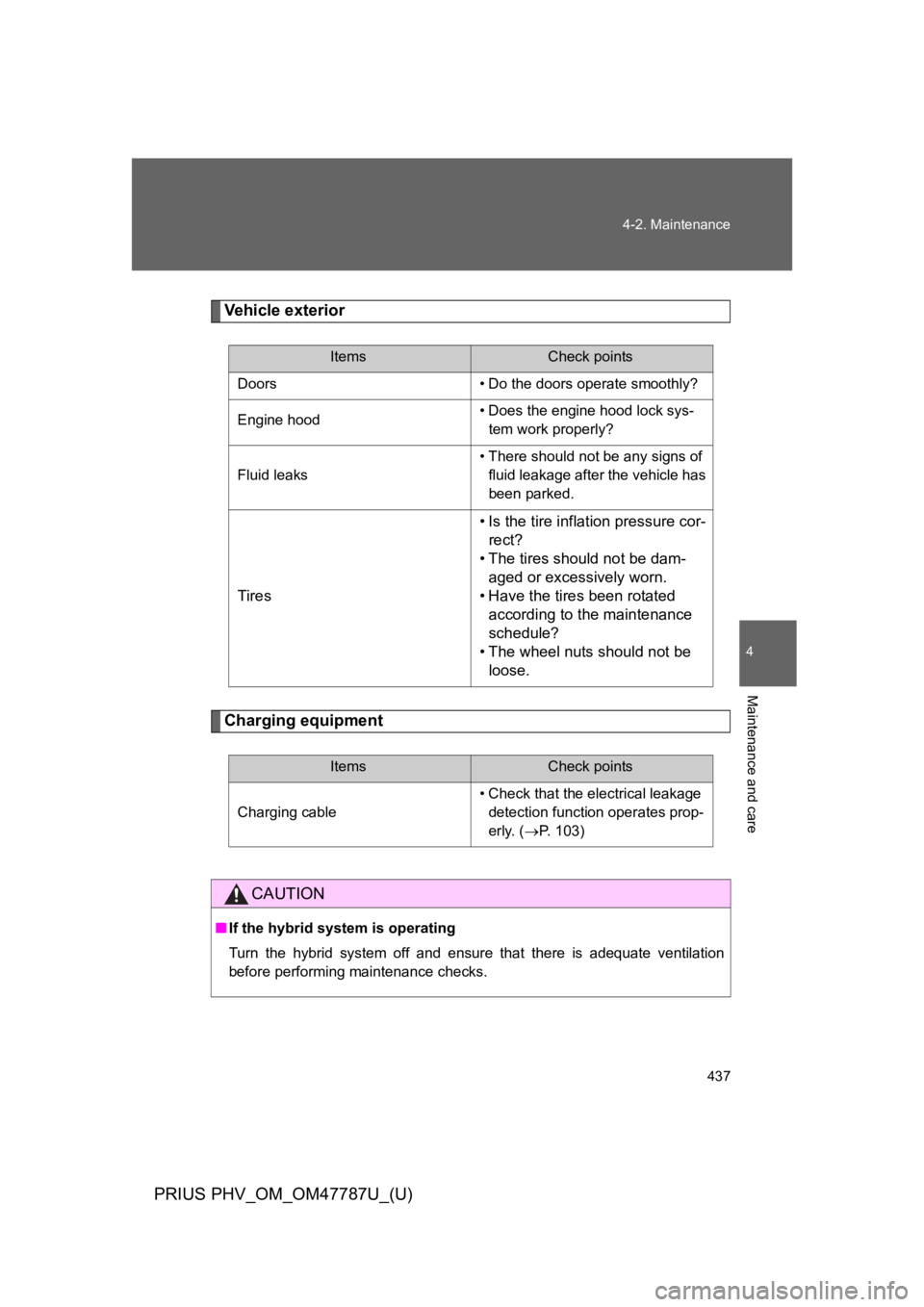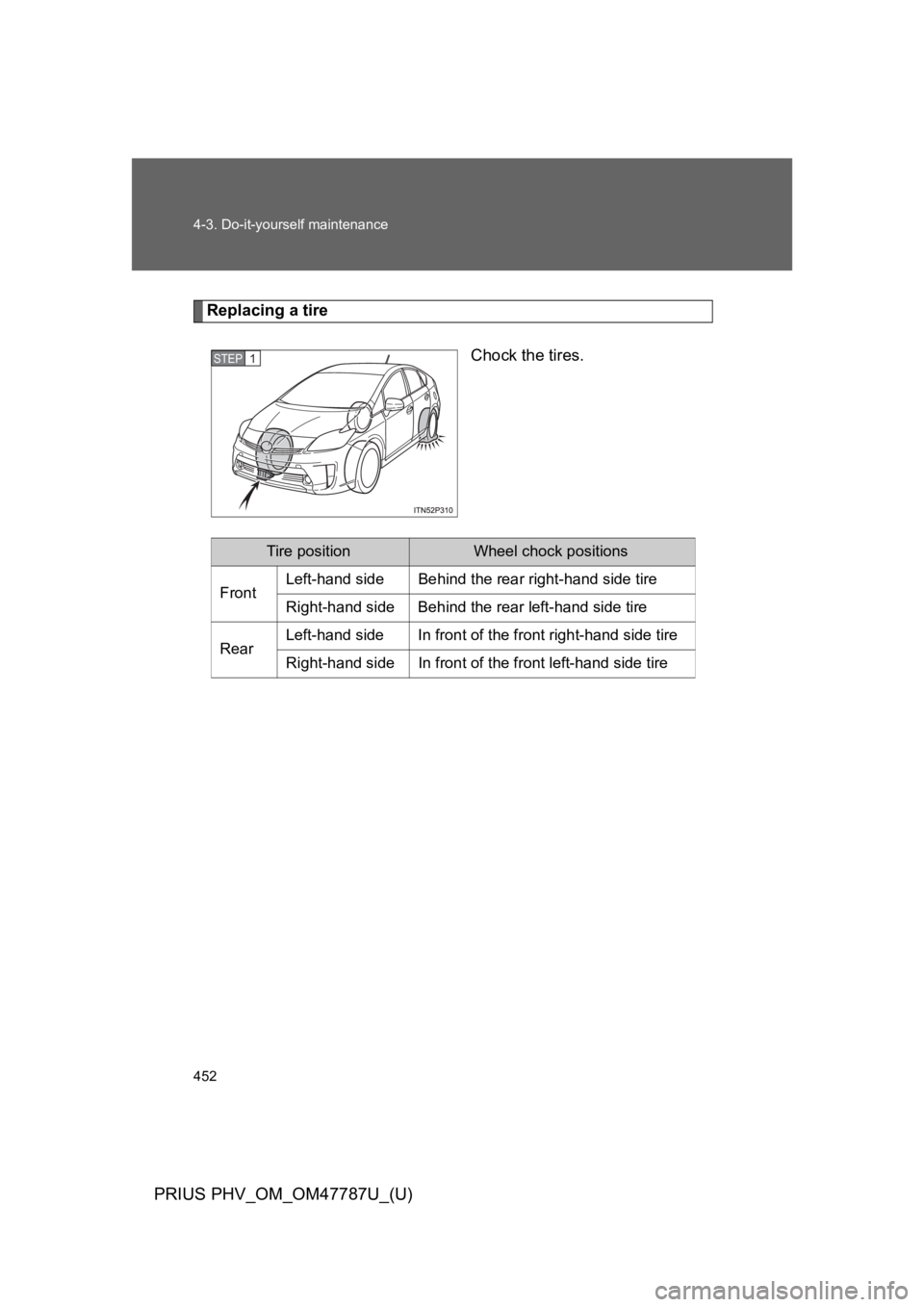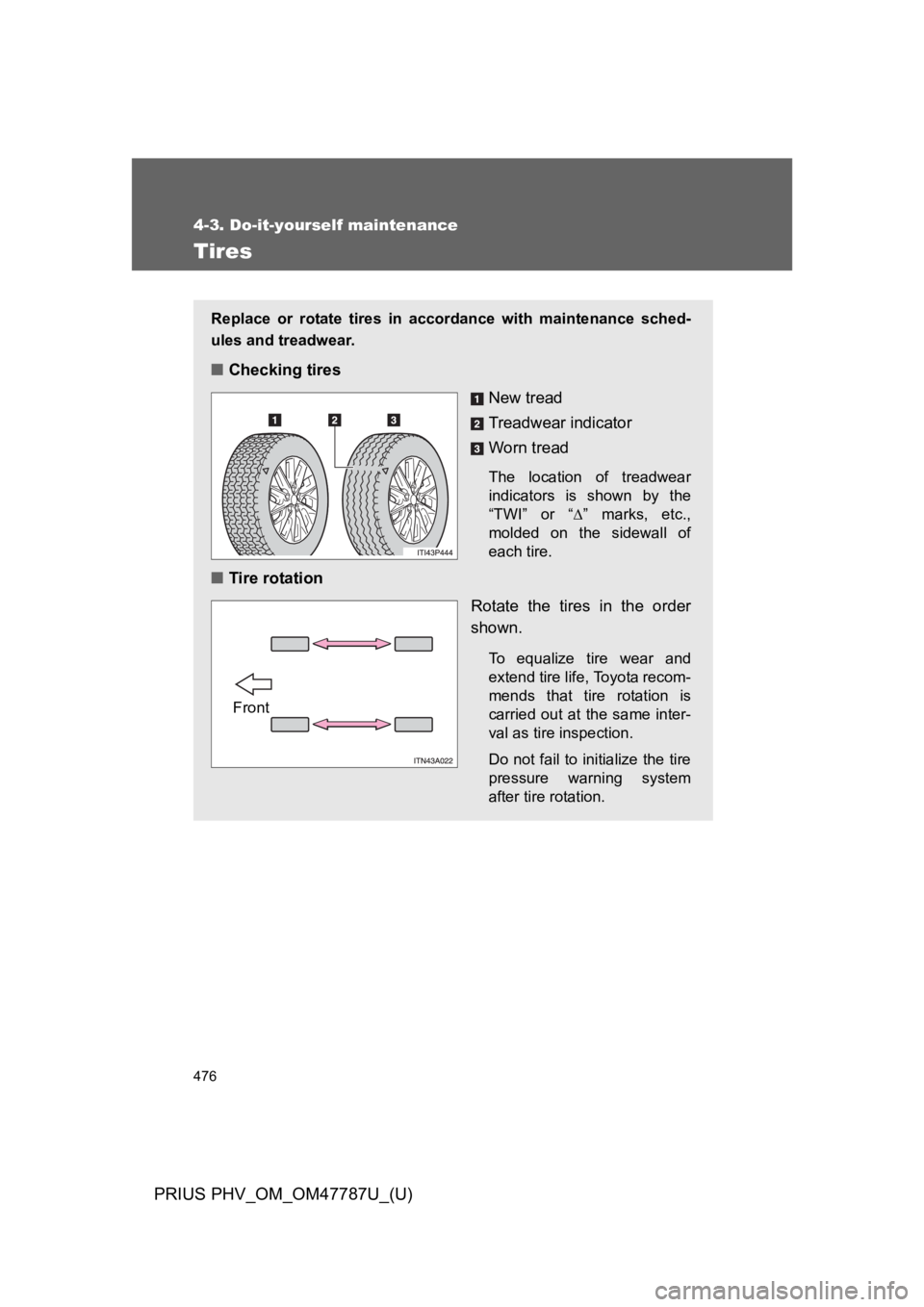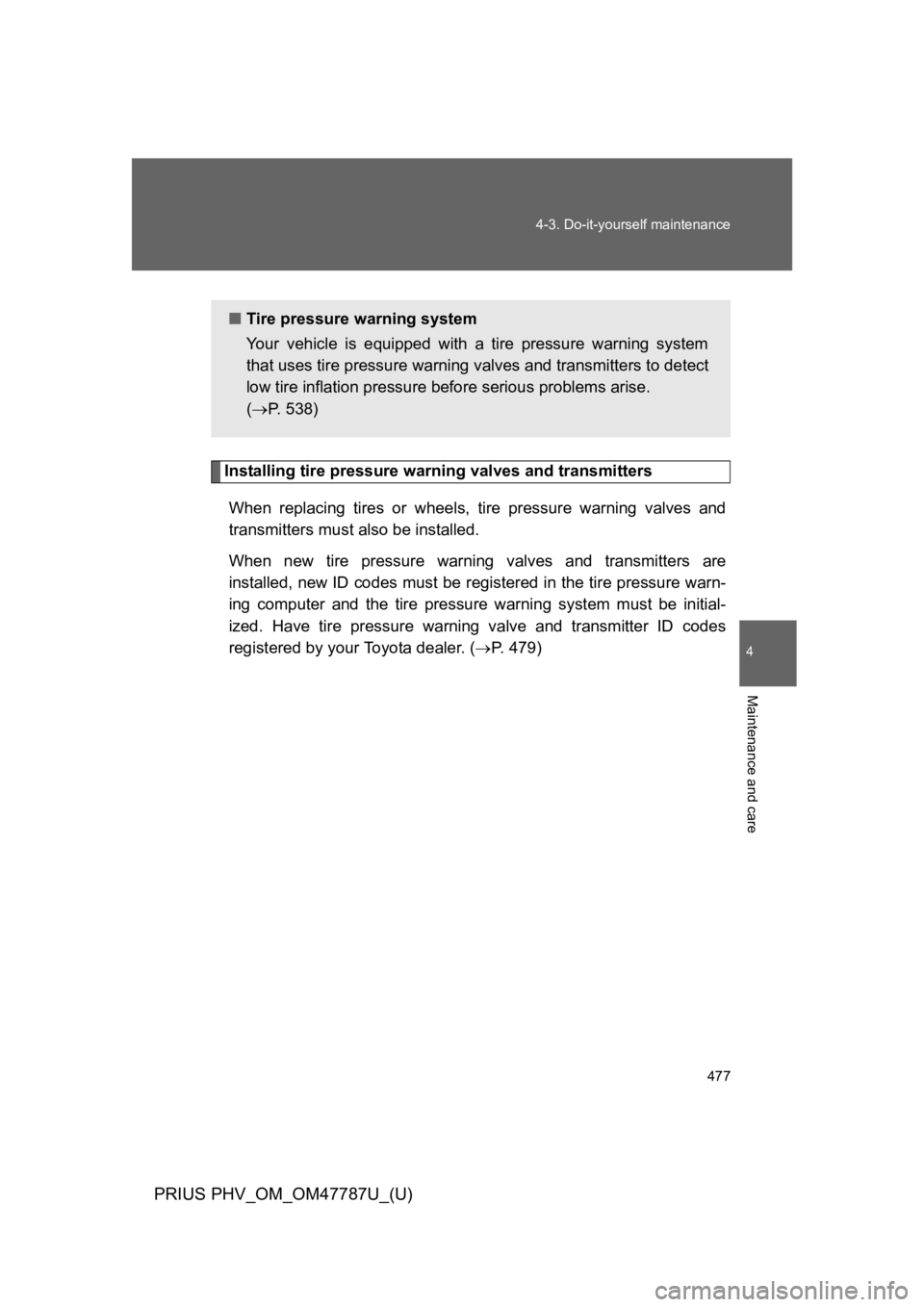tires TOYOTA PRIUS PLUG-IN 2013 User Guide
[x] Cancel search | Manufacturer: TOYOTA, Model Year: 2013, Model line: PRIUS PLUG-IN, Model: TOYOTA PRIUS PLUG-IN 2013Pages: 704, PDF Size: 19.59 MB
Page 378 of 704

352
2-5. Driving information
PRIUS PHV_OM_OM47787U_(U)
CAUTION
■Driving with snow tires
Observe the following precautions to reduce the risk of accidents.
Failure to do so may result in a loss of vehicle control and cause death or
serious injury.
●Use tires of the size specified.
●Maintain the recommended level of air pressure.
●Do not drive in excess of 75 mph (120 km/h), regardless of the type of
snow tires being used.
●Use snow tires on all, not just some wheels.
■Driving with tire chains
Observe the following precautions to reduce the risk of accidents.
Failure to do so may result in the vehicle being unable to be driven safely,
and may cause death or serious injury.
●Do not drive in excess of the speed limit specified for the tire chains being
used, or 30 mph (50 km/h), whichever is lower.
●Avoid driving on bumpy road surfaces or over potholes.
●Avoid sudden acceleration, abrupt steering, sudden braking and shifting
operations that cause sudden engine braking.
●Slow down sufficiently before entering a curve to ensure that vehicle con-
trol is maintained.
Page 379 of 704

353
2-5. Driving information
PRIUS PHV_OM_OM47787U_(U)
2
When driving
NOTICE
■Repairing or replacing snow tires
Request repairs or replacement of snow tires from Toyota dealers or legiti-
mate tire retailers.
This is because the removal and attachment of snow tires affects the opera-
tion of the tire pressure warning valves and transmitters.
■Fitting tire chains
The tire pressure warning valves and transmitters may not function correctly
when tire chains are fitted.
Page 461 of 704

437
4-2. Maintenance
PRIUS PHV_OM_OM47787U_(U)
4
Maintenance and care
Ve h i c l e e x t e r i o r
Charging equipment
ItemsCheck points
Doors • Do the doors operate smoothly?
Engine hood•Does the engine hood lock sys-
tem work properly?
Fluid leaks
•There should not be any signs of
fluid leakage after the vehicle has
been parked.
Tires
•Is the tire inflation pressure cor-
rect?
•The tires should not be dam-
aged or excessively worn.
•Have the tires been rotated
according to the maintenance
schedule?
•The wheel nuts should not be
loose.
ItemsCheck points
Charging cable
•Check that the electrical leakage
detection function operates prop-
erly. (→P. 1 0 3 )
CAUTION
■If the hybrid system is operating
Turn the hybrid system off and ensure that there is adequate ventilation
before performing maintenance checks.
Page 476 of 704

452
4-3. Do-it-yourself maintenance
PRIUS PHV_OM_OM47787U_(U)
Replacing a tire
Chock the tires.STEP 1
Tire positionWheel chock positions
FrontLeft-hand side Behind the rear right-hand side tire
Right-hand side Behind the rear left-hand side tire
RearLeft-hand side In front of the front right-hand side tire
Right-hand side In front of the front left-hand side tire
Page 480 of 704

456
4-3. Do-it-yourself maintenance
PRIUS PHV_OM_OM47787U_(U)
CAUTION
■Using the tire jack
Improper use of the tire jack may cause the vehicle to suddenly fall off
the jack, leading to death or serious injury.
Observe the following precautions:
●Do not use the tire jack for any purpose other than replacing tires or
installing and removing tire chains.
●Only use the tire jack that comes with this vehicle for replacing a flat
tire.
Do not use it on other vehicles, and do not use other tire jacks for
replacing tires on this vehicle.
●Always check that the tire jack is securely set to the jack point.
●Do not put any part of your body under the vehicle while it is supported
by the jack.
●Do not start or run the hybrid system while your vehicle is supported by
the jack.
●Do not raise the vehicle while someone is inside.
●When raising the vehicle, do not put an object on or under the jack.
●Do not raise the vehicle to a height greater than that required to
replace the tire.
●Use a jack stand if it is necessary to get under the vehicle.
Ta k e p a r t i c u l a r c a r e w h e n l o w e r i n g t h e v e h i c l e t o e n s u r e t h a t n o o n e
working on or near the vehicle may be injured.
Page 482 of 704

458
4-3. Do-it-yourself maintenance
PRIUS PHV_OM_OM47787U_(U)
NOTICE
■When replacing the tires
When removing or fitting the wheels, tires or the tire pressure warning
valve and transmitter, contact your To y o t a d e a l e r a s t h e t i r e p r e s s u r e
warning valve and transmitter may be damaged if not handled correctly.
■To a v o i d d a m a g e t o t h e t i r e p r e s s u r e w a r n i n g v a l v e s a n d t r a n s m i t -
ters
When a tire is repaired with liquid sealants, the tire pressure warning
valve and transmitter may not operate properly. If a liquid sealant is
used, contact your Toyota dealer or other qualified service shop as soon
as possible. Make sure to replace the tire pressure warning valve and
transmitter when replacing the tire. (→P. 4 7 7 )
Page 500 of 704

476
4-3. Do-it-yourself maintenance
PRIUS PHV_OM_OM47787U_(U)
Tires
Replace or rotate tires in accordance with maintenance sched-
ules and treadwear.
■Checking tires
New tread
Treadwear indicator
Worn tread
The location of treadwear
indicators is shown by the
“TWI” or “∆” marks, etc.,
molded on the sidewall of
each tire.
■Tire rotation
Rotate the tires in the order
shown.
To e q u a l i z e t i r e w e a r a n d
extend tire life, Toyota recom-
mends that tire rotation is
carried out at the same inter-
val as tire inspection.
Do not fail to initialize the tire
pressure warning system
after tire rotation.
Front
Page 501 of 704

477
4-3. Do-it-yourself maintenance
PRIUS PHV_OM_OM47787U_(U)
4
Maintenance and care
Installing tire pressure warning valves and transmitters
When replacing tires or wheels, tire pressure warning valves and
transmitters must also be installed.
When new tire pressure warning valves and transmitters are
installed, new ID codes must be registered in the tire pressure warn-
ing computer and the tire pressure warning system must be initial-
ized. Have tire pressure warning valve and transmitter ID codes
registered by your Toyota dealer. (→P. 4 7 9 )
■Tire pressure warning system
Yo u r v e h i c l e i s e q u i p p e d w i t h a t i r e p r e s s u r e w a r n i n g s y s t e m
that uses tire pressure warning valves and transmitters to detect
low tire inflation pressure before serious problems arise.
(→P. 5 3 8 )
Page 502 of 704

478
4-3. Do-it-yourself maintenance
PRIUS PHV_OM_OM47787U_(U)
Initializing the tire pressure warning system
■The tire pressure warning system must be initialized in the fol-
lowing circumstances:
●When rotating front and rear tires which have different tire infla-
tion pressures
●When changing the tire size
When the tire pressure warning system is initialized, the current
tire inflation pressure is set as the benchmark pressure.
■How to initialize the tire pressure warning system
Park the vehicle in a safe place and turn the “POWER” switch
off.
Initialization cannot be performed while the vehicle is moving.
Adjust the tire inflation pressure to the specified cold tire infla-
tion pressure level. (→P. 6 1 9 )
Make sure to adjust the tire pressure to the specified cold tire
inflation pressure level. The tire pressure warning system will
operate based on this pressure level.
Turn the “POWER” switch to ON mode.
STEP 1
STEP 2
STEP 3
Page 504 of 704

480
4-3. Do-it-yourself maintenance
PRIUS PHV_OM_OM47787U_(U)
■When to replace your vehicle’s tires
Tires should be replaced if:
●You have tire damage such as cuts, splits, cracks deep enough to
expose the fabric, and bulges indicating internal damage.
●A tire goes flat repeatedly or cannot be properly repaired due to the
size or location of a cut or other damage.
If you are not sure, consult with your Toyota dealer.
■Replacing tires and wheels
If the ID code of the tire pressure warning valve and transmitter is not
registered, the tire pressure warning system will not work properly. After
driving for about 20 minutes, the tire pressure warning light blinks for
1 minute and stays on to indicate a system malfunction.
■Tire life
Any tire over 6 years old must be checked by a qualified technician even
if it has seldom or never been used or damage is not obvious.
■Routine tire inflation pressure checks
The tire pressure warning system does not replace routine tire inflation
pressure checks. Make sure to check tire inflation pressure as part of
your routine of daily vehicle checks.